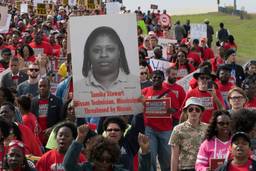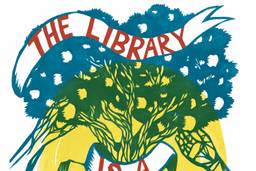"Revolutionary Suicide": On the Horrors of Jonestown
“Dad—I see no way out—I agree with your decision—I fear only that without you the world may not make it to Communism.” An excerpt from a letter found on the body of Jim Jones.
David Moberg

This story was first published in the December 6, 1978 issue of In These Times. We are reprinting it here as a remembrance of the late reporter David Moberg (1943−2022), who worked at the magazine since its inception in 1976.
Reverend Jim Jones did not bring the world closer to communism in his 47 years. But with an ironic twist characteristic of so much of his life and teachings, he did bring his agricultural colony in Jonestown, Guyana, close to—perhaps several steps beyond in some ways—the most die-hard anti-communist vision of a socialist future.
“It could have been really nice,” Edith Bogue, a survivor now detained in the Park Hotel in Georgetown, still says. It was precisely that kind of hope that sustained so many people, perhaps even to their death, in the face of massive evidence of Jones’ folly. Some people living at Jonestown were undoubtedly seriously disturbed psychologically. Others appeared to have drifted in, perhaps seeing it as a refuge from an already hard life — having “nothing to lose,” as survivors say, or attracted to something about Jim Jones or his promises. Many others, however, were idealists, humanitarians and politically dedicated socialists.
Overwhelmed by the question of how any group would choose to follow their leader into mass suicide, observers have been less inclined to ask another pressing and painful question: how could people dedicated to ideals of racial equality, human brotherhood, abolition of economic exploitation and socialism produce and support with such intensity a small society that violated and inverted so many of its principles?
END JUSTIFIES THE MEANS
It is easy to dismiss Jonestown as the work of psychotics or the consequences of religious cultism, but the dark side of Jonestown was a perverted product of the left as well. “The church was just a front for the socialist movement,” Michael Prokes, a TV journalist turned People’s Temple member, insisted.
Jim Jones spun out paranoid fantasies of CIA machinations. He caught himself up in the dilemma of secretly being a socialist while publicly appearing a religious crusader. He exaggerated the political oppressiveness of American society to the point that he saw no hope for change. He justified ruthless authoritarianism as “proletarian dictatorship.“
He wrote off the majority of Americans as inevitably reactionary and believed anything was legitimate to pursue his goal of socialism. These political tendencies were not incidental to the deaths at Jonestown; they were directly connected with them.
“I heard Jim Jones say so many times, “The end justifies the means,’ ” said Harold Cordell, 42. A follower of Jones from Indianapolis for the past 24 years, Cordell escaped death at Jonestown and left behind five children in the heap of cyanide-poisoned bodies, two of whom had pointedly refused his plea to leave Jonestown with him. “He justified lying to achieve a socialist society. You can imprison large numbers of people. You could kill thousands to make things better for others.”
REVOLUTIONARY SUICIDE
In the end, the means included 909 “revolutionary suicides” (some of them, especially those of children, more properly called murder). Inspired by the term introduced earlier by Black Panther leader Huey Newton, and citing precedents such as the self-immolation of Buddhist monks, Jones argued increasingly after he settled in Jonestown, in the summer of 1977, that it was better to kill oneself than to be defeated by one’s enemies.
Such an obsession with “being ready to die for the revolution,” which had started during his years in California, was refined, in Guyana, into at least one practice suicide and numerous alerts where Jones would ask, “Who is ready to die for Jonestown?” (Accounts differ about the alerts — called either “White Night” or “White Knight” — and the number of death rehearsals.)
But, on Saturday, Nov. 18, after five people, including Congressman Leo Ryan, were killed at the nearby airstrip, there was a difference; more guns for the security forces, administration of the Flav-R-Aid to the children first, and cyanide, quickly producing agonized twists of dying bodies.
How could it have happened? Only part of the story has come out, despite the volume of print and images, and more will undoubtedly come with the books (at least four already out or under contract) and reports to come. To say that Jones was a madman is only to ask what was his madness — and that, like all insanity, it mirrored the values of the madman’s culture.
Survivors claim that Jones was a socialist from his early days as a minister in Indianapolis, where he was a controversial advocate of integration. To the very end, he maintained his support of the Soviet Union as the vanguard of world revolution. But he chose to appear as a preacher.
“Telling people about socialism in America, you’d get 20 people,” explained Jones aide Tim Carter, who, along with Prokes and another temple member, escaped death by being chosen to take a suitcase of money and letters to the Soviet embassy in Georgetown. “But as a preacher you could get a large audience.”

SEXUAL FAVORS
Just as his fear of open advocacy of socialism was a product of the McCarthyite ’50s, so was his obsession with the threat of nuclear holocaust. It contributed to his move, in 1966, to Redwood Valley, near Ukiah, Calif., where his advocacy of racial integration brought attacksfrom townspeople. These encounters fed his already-strong sense of doom and persecution. But his success in attracting followers encouraged his grandiose sense of self.
As he grew more influential, it seems, he became more arrogant. “I’m the only God you’ll ever know,” he told followers. While preaching sexual abstention for members, he claimed exaggerated sexual prowess and demanded sexual favors from numerous women and men in his following — often justifying it either as “therapy,” as a way of keeping his followers in the movement, or as simply a cure for his prostate troubles.
Jones focused all attention on himself. He tried to maintain distrust among followers, even while he encouraged general communal warmth. He doled out secret information among various loyal associates, on a “need to know basis.” He discouraged close family ties. For example, on Jonestown’s last day, one couple finally revealed to their daughter their plans to leave. They had not talked earlier for fear that the children would turn them in. Ironically, two of their daughters had hatched the same escape plans and had the same fear. Yet, two others refused to leave and cursed their family’s decision.
He tried to separate members from anyone on the outside of the People’s Temple. He insisted on being called “Dad” or “Father” by all of the “brothers and sisters” in the giant communal family, but he also insisted — especially in Jonestown — that he was “dictator of the proletariat.“
His paranoia and megalomania set upon each other in a deadly spiral. Having elevated himself so high, having shown the hubris to challenge the gods and claim perfection, Jones could tolerate no deviation from his desires, and apparently came to see the whole world revolving around him. Thus, every disagreement, every infraction of a rule, every question from outside, became part of a conspiracy to bring him down. No criticism was ever permitted.
His closed services — for members only — began to include more discipline, more embarrassment, more punishment. He picked up from Synanon and other groups’ ideas about “confrontation therapy.” Serious “therapy” required beatings. But as the efforts to solidify the community under his control increased, so did the threat that came with anyone’s departure. That was especially true since departing members had increasingly grisly tales to tell of Jones’ possessive abuse of his followers.
TERRIFIED OF RYAN’S VISIT
When publicity broke in New West in August 1977, hundreds of members slipped away from their jobs to follow Jones into the wilds of Guyana. Jones was also fleeing Grace Stoen, a former member who was trying to recover her child that Jones claimed, loss of little John-John appeared to be one of Jones’ greatest fears.
Although the agricultural experiment had been progressing, the influx of larger numbers of raw recruits who knew nothing of farming strained the capacity of the place, and the farming declined. Jones had enough money — estimated by law a lawyer who died in the suicide at over $13 million in various accounts, plus well over $1 million in cash at Jonestown — that could have sustained the community comfortably. Instead, he drove people harder, fed them less, housed them in inadequate quarters, and stepped up discipline. He spun up more wild stories to demonstrate the impossibility of escape — tigers and snakes waiting in the jungle, the government granted him the right to shoot anyone who fled, and the American embassy promised cooperation to send back anyone who escaped.
Each government, legal or press inquiry, each step of the Stoer law suit, each difficulty with the outside world convinced Jones more and more of the vast plot to destroy him. He retreated to his house, reportedly with continual high fever, taking drugs, reading voraciously (copies of In These Times, sad to say, discovered in his house at Jonestown). His services concentrated on harangues about current events and the rise of fascism, along with severe beatings of all who complained, although beatings were replaced by hard labor late last spring after a trusted member defected from the community.
The Ryan visit terrified him. When people decided to leave with the Congressman, Jones apparently decided there was no way out, even though negotiations had already begun with the Soviet embassy in Georgetown for sanctuary in the USSR.
WE TRIED
Although many balked at the real “White Night,” in the end, only three people — including Jones — apparently died from gunshots. Survivors, such as Prokes, who only by chance missed the suicide, cannot understand why more members did not doubt the wisdom of the suicide and escape. “It’s the mystery of mysteries,” he says.
Yet resignation, mixed with fear, and, for many, a genuine belief in Jim Jones’ capability to lead them to a “higher plane” through revolutionary suicide probably led to the ghoulish, brightly colored stacks of bodies found around the Jonestown pavilion. On the arm of one young girl was written, “We tried.” So many thought.
Now, the few dozen survivors, most still in Guyana, replay the final days in interviews (some sold for thousands of dollars to free-spending journalists) or in their dreams. Tim Carter tried hard one morning last week to wash away, with coffee, the Nembutal fuzz that had given him his first good night’s sleep in more than ten days. “I dreamed I saw my wife and daughter,” he said. “They were alive and reaching toward me. Then I woke and remembered they were dead. I wonder if those dreams will ever end.”
David Moberg, a former senior editor of In These Times, was on staff with the magazine from when it began publishing in 1976 until his passing in July 2022. Before joining In These Times, he completed his work for a Ph.D. in anthropology at the University of Chicago and worked for Newsweek. He received fellowships from the John D. and Catherine T. MacArthur Foundation and the Nation Institute for research on the new global economy.








